Where Can I Buy 20 Sided Dice Near Me

Four traditional die showing all vi different sides.
Die of different sizes being thrown in slow motion.
Dice (singular die or die [1]) are pocket-sized, throwable objects with marked sides that tin can rest in multiple positions. They are used for generating random numbers, commonly every bit part of tabletop games, including dice games, lath games, part-playing games, and games of chance.
A traditional die is a cube with each of its six faces marked with a dissimilar number of dots (pips) from ane to half dozen. When thrown or rolled, the die comes to rest showing a random integer from one to six on its upper surface, with each value being every bit likely. Dice may also have polyhedral or irregular shapes and may have faces marked with numerals or symbols instead of pips. Loaded die are designed to favor some results over others for cheating or amusement.
History [edit]
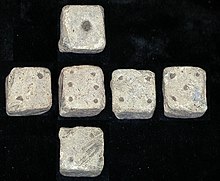
Dice accept been used since before recorded history, and it is uncertain where they originated. It is theorized that dice developed from the practice of fortune-telling with the talus of hoofed animals, colloquially known as knucklebones.[ii] The Egyptian game of senet was played with flat 2-sided throwsticks which indicated the number of squares a player could move, and thus functioned as a form of die. Senet was played before 3000 BC and upwardly to the 2nd century Ad.[3] Bone dice from Skara Brae, Scotland accept been dated to 3100–2400 BC.[4] Excavations from graves at Mohenjo-daro, an Indus Valley civilization settlement, unearthed terracotta dice dating to 2500–1900 BC.[5]

Games involving die are mentioned in the ancient Indian Rigveda, Atharvaveda, Mahabharata and Buddhist games list.[6] There are several biblical references to "casting lots" (Hebrew: יפילו גורל yappîlū ḡōrāl), as in Psalm 22, indicating that dicing (or a related activity) was commonplace when the psalm was composed. Knucklebones was a game of skill played in aboriginal Hellenic republic; a derivative grade had the iv sides of basic receive different values like mod dice.[7]

Although gambling was illegal, many Romans were passionate gamblers who enjoyed dicing, which was known every bit aleam ludere ("to play at dice"). In that location were ii sizes of Roman dice. Tali were large dice inscribed with one, 3, iv, and half-dozen on four sides. Tesserae were smaller dice with sides numbered from one to six.[nine] Xx-sided dice engagement dorsum to the 2nd century AD[ten] and from Ptolemaic Egypt as early as the 2nd century BC.[8]

A collection of historical dice from various regions of Asia
Dominoes and playing cards originated in China every bit developments from dice.[11] The transition from die to playing cards occurred in China effectually the Tang dynasty (618–907 Advertising), and coincides with the technological transition from rolls of manuscripts to block printed books.[12] In Nihon, dice were used to play a popular game called sugoroku. There are 2 types of sugoroku. Ban-sugoroku is similar to backgammon and dates to the Heian period (794–1185), while e-sugoroku is a racing game.[13]
Utilize [edit]
Dice are thrown onto a surface either from the hand or from a container designed for this (such every bit a cup or tray). The face of the die that is uppermost when information technology comes to rest provides the value of the throw.
The effect of a die scroll is determined by the manner it is thrown, according to the laws of classical mechanics. A die roll is made random by uncertainty in small factors such as tiny movements in the thrower's paw; they are thus a crude form of hardware random number generator.
1 typical contemporary die game is craps, where two dice are thrown simultaneously and wagers are fabricated on the full value of the two dice. Dice are frequently used to introduce randomness into lath games, where they are often used to make up one's mind the altitude through which a piece will move along the board (as in backgammon and Monopoly).
Structure [edit]
Arrangement [edit]
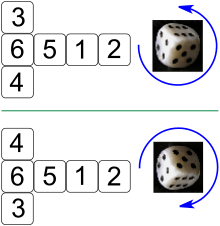
Mutual dice are modest cubes, near oft one.6 cm (0.63 in) across,[14] whose faces are numbered from i to 6, usually by patterns of circular dots called pips. (While the use of Arabic numerals is occasionally seen, such dice are less mutual.)
Opposite sides of a mod die traditionally add up to seven, requiring the 1, 2, and 3 faces to share a vertex.[15] The faces of a dice may be placed clockwise or counterclockwise about this vertex. If the 1, two, and three faces run counterclockwise, the dice is called "correct-handed". If those faces run clockwise, the dice is chosen "left-handed". Western dice are normally correct-handed, and Chinese die are normally left-handed.[16]

Typical facets showing the more compact pip organisation of an Asian-manner dice (top) vs. a Western-style dice (bottom)
The pips on standard six-sided die are bundled in specific patterns every bit shown. Asian style dice bear similar patterns to Western ones, but the pips are closer to the middle of the face; in addition, the pips are differently sized on Asian mode die, and the pips are colored red on the 1 and four sides. Blood-red fours may exist of Indian origin.[xvi] [17]
Manufacturing [edit]

Western, Asian, and casino die
Non-precision dice are manufactured via the plastic injection molding procedure, ofttimes made of polymethyl methacrylate (PMMA). The pips or numbers on the dice are a role of the mold. Dissimilar pigments can be added to the dice to make them opaque or transparent, or multiple pigments may exist added to brand the die speckled or marbled.[18]
The coloring for numbering is achieved past submerging the die entirely in paint, which is immune to dry. The die is then polished via a tumble finishing process similar to rock polishing. The abrasive agent scrapes off all of the paint except for the indents of the numbering. A finer abrasive is then used to polish the dice. This procedure besides produces the smoother, rounded edges on the die.[19]
Precision casino dice may have a polished or sand cease, making them transparent or translucent respectively. Casino dice take their pips drilled, then filled flush with a pigment of the same density equally the material used for the dice, such that the eye of gravity of the dice is as close to the geometric eye every bit possible. This mitigates concerns that the pips will cause a minor bias.[twenty] All such die are stamped with a serial number to prevent potential cheaters from substituting a die. Precision backgammon dice are made the same way; they tend to exist slightly smaller and accept rounded corners and edges, to permit amend movement within the die loving cup and finish forceful rolls from damaging the playing surface.
Etymology and terms [edit]
The word die comes from Old French dé; from Latin datum "something which is given or played".[21]
While the terms ace, deuce, trey, cater, cinque and sice are generally obsolete, with the names of the numbers preferred, they are still used by some professional gamblers to designate different sides of the dice. Ace is from the Latin as, meaning "a unit";[22] the others are 2 to 6 in Old French.[23]
When rolling two dice, certain combinations have slang names. The term snake eyes is a ringlet of one pip on each dice. The Online Etymology Lexicon traces use of the term as far back as 1919.[24] The US term boxcars, also known as midnight, is a roll of vi pips on each dice. The pair of six pips resembles a pair of boxcars on a freight train. Many rolls have names in the game of craps.
Unicode representation [edit]
Using Unicode characters, the faces ⚀ ⚁ ⚂ ⚃ ⚄ ⚅ can be shown in text using the range U+2680 to U+2685 or using decimal ⚀ to ⚅.[25]
Loaded dice [edit]
A loaded, weighted, crook, or crooked die is one that has been tampered with so that it will land with a specific side facing upwards more or less ofttimes than a off-white dice would. At that place are several methods for making loaded dice, including rounded faces, off-square faces, and weights. Casinos and gambling halls oftentimes use transparent cellulose acetate die as tampering is easier to detect than with opaque dice.[26]
Variants [edit]
Polyhedral dice [edit]
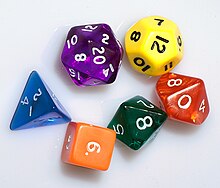
A typical set of roleplaying dice in various colors. They consist of the v Platonic solids, forth with a 10-sided die that is also used for generating percentages.
Various shapes like two-sided or four-sided dice are documented in archaeological findings; for example, from Ancient Egypt and the Middle East. While the cubical six-sided dice became the most mutual type in many parts of the world, other shapes were always known, similar 20-sided dice in Ptolemaic and Roman times.
The modern tradition of using sets of polyhedral dice started around the end of the 1960s when not-cubical dice became popular among players of wargames,[27] and since have been employed extensively in role-playing games and trading card games. Dice using both the numerals 6 and 9, which are reciprocally symmetric through rotation, typically distinguish them with a dot or underline.
Common variations [edit]
Dice are often sold in sets, matching in color, of half dozen different shapes. Five of the dice are shaped like the Ideal solids, whose faces are regular polygons. Aside from the cube, the other 4 Ideal solids accept 4, 8, 12, and 20 faces, allowing for those number ranges to be generated. The only other common non-cubical die is the 10-sided dice, a pentagonal trapezohedron die, whose faces are ten kites, each with two dissimilar edge lengths, three different angles, and two different kinds of vertices. Such sets ofttimes include a second 10-sided die either of contrasting colour or numbered by tens, allowing the pair of x-sided dice to be combined to generate numbers between ane and 100.
Using these die in various ways, games can closely judge a multifariousness of probability distributions. For instance, 10-sided dice tin be rolled in pairs to produce a uniform distribution of random percentages, and summing the values of multiple dice volition produce approximations to normal distributions.[28]
Dissimilar other common dice, a 4-sided (tetrahedral) die does not have a side that faces upward when it is at balance on a surface, and then it must be read in a different mode. On some four-sided dice, each face features multiple numbers, with the same number printed near each vertex on all sides. In this instance, the number around the vertex pointing up is used. Alternatively, the numbers on a tetrahedral die tin exist placed at the middles of the edges, in which case the numbers around the base are used.
Unremarkably, the faces on a die volition be placed then reverse faces will add up to one more than the number of faces. (This is not possible with four-sided die and dice with an odd-number of faces.) Some dice, such every bit those with ten sides, are ordinarily numbered sequentially beginning with 0, in which example the opposite faces will add to one less than the number of faces.
Some twenty-sided die have a different organization used for the purpose of keeping track of an integer that counts down, such as wellness points. These spindown die are arranged such that side by side integers announced on adjacent faces, allowing the user to easily find the next lower number. They are commonly used with collectible bill of fare games.[29]
| Faces/ Sides | Shape | Notes | |
|---|---|---|---|
| 4 | Tetrahedron | | Each confront has three numbers, arranged such that the upright number, placed either virtually the vertex or virtually the contrary edge, is the same on all three visible faces. The upright numbers represent the value of the whorl. This dice does non roll well and thus it is usually thrown into the air instead. |
| 6 | Cube | | A common die. The sum of the numbers on reverse faces is 7. |
| 8 | Octahedron | | Each face is triangular and the die resembles two square pyramids attached base-to-base. Unremarkably, the sum of the opposite faces is 9. |
| ten | Pentagonal trapezohedron | | Each face is a kite. The die has two precipitous corners, where five kites run into, and ten blunter corners, where iii kites meet. The ten faces usually bear numbers from nada to nine, rather than one to ten (zero being read as "x" in many applications). Ofttimes all odd numbered faces converge at one sharp corner, and the even ones at the other. The sum of the numbers on opposite faces is usually 9 (if numbered 0–9) or eleven (if numbered i–10). |
| 12 | Dodecahedron | | Each confront is a regular pentagon. The sum of the numbers on opposite faces is usually thirteen. |
| xx | Icosahedron | | Faces are equilateral triangles. Icosahedra take been establish dating to Roman/Ptolemaic times, just information technology is not known if they were used as gaming dice. Modernistic dice with 20 sides are sometimes numbered 0–ix twice as an culling to 10-sided die. The sum of the numbers on reverse faces is 21 if numbered 1–xx. |
Rarer variations [edit]
"Compatible fair dice" are dice where all faces have equal probability of consequence due to the symmetry of the die equally it is face-transitive. In add-on to the Ideal solids, these theoretically include:
- Bipyramids, the duals of the infinite prepare of prisms, with triangle faces: any multiple of 4 (and so that a face will confront) above eight
- Catalan solids, the duals of the 13 Archimedean solids: 12, 24, 30, 48, lx, 120 sides
- Disphenoids, an infinite set of tetrahedra made from congruent non-regular triangles: four sides. This is a less symmetric tetrahedron than the Ideal tetrahedron, but still sufficiently symmetrical to be face-transitive. Similarly, pyritohedra and tetartoids are less symmetrical but still face-transitive dodecahedra: 12 sides.
- Trapezohedra, the duals of the infinite prepare of antiprisms, with kite faces: any fifty-fifty number non divisible by 4 (so that a face up will confront) to a higher place 6
Ii other types of polyhedra are technically not face-transitive, simply are nevertheless fair dice due to symmetry:
- antiprisms: the basis of barrel dice
- prisms: the basis of long die and teetotums
Long dice and teetotums tin in principle be made with any number of faces, including odd numbers.[30] Long dice are based on the infinite set of prisms. All the rectangular faces are mutually face-transitive, so they are as probable. The two ends of the prism may be rounded or capped with a pyramid, designed so that the die cannot residuum on those faces. 4-sided long dice are easier to scroll than tetrahedra, and are used in the traditional board games dayakattai and daldøs.
| Faces/ sides | Shape | Epitome | Notes |
|---|---|---|---|
| one | Möbius strip or sphere | | Nearly commonly a joke dice, this is either a sphere with a 1 marked on information technology or shaped like a Möbius strip. |
| 2 | Cylinder | | A money flip. Some coins with 1 marked on i side and ii on the other are available, but about simply utilize a mutual coin. |
| three | Rounded-off triangular prism | | A long die intended to be rolled lengthwise. When the die is rolled, 1 edge (rather than a side) appears facing upwards. On either side of each edge the same number is printed (from 1 to 3). The numbers on either side of the up-facing edge are read as the outcome of the die roll. |
| 4 | Capped four-sided long die | | A long die intended to exist rolled lengthwise. It cannot stand on end as the ends are capped. |
| 5 | |||
| Triangular prism | | A prism that is thin enough to land either on its "edge" or "confront". When landing on an edge, the result is displayed by digits (2–iv) shut to the prism'south summit edge. The triangular faces are labeled with the digits i and five. | |
| Capped 5-sided long die | | Five-faced long die for the Korean Game of Dignitaries; notches indicating values are cut into the edges, since in an odd-faced long dice these state uppermost. | |
| six | Capped 6-sided long dice | | Two six-faced long dice are used to simulate the activity of scoring runs and taking wickets in the game of cricket. Originally played with labelled six-sided pencils, and often referred to as pencil cricket. |
| 7 | Pentagonal prism | | Similar in constitution to the 5-sided die. Seven-sided dice are used in a seven-player variant of backgammon. Seven-sided dice are described in the 13th century Libro de los juegos as having been invented by Alfonso X in club to speed up play in chess variants.[31] [32] |
| 12 | Rhombic dodecahedron | | Each face is a rhomb. |
| Hexagonal trapezohedron | | Each face is a kite. | |
| fourteen | Heptagonal trapezohedron | | Each face is a kite. |
| 16 | Octagonal bipyramid | | Each face is an isosceles triangle. |
| Octagonal trapezohedron | | Each face is a kite. | |
| 18 | Rounded rhombicuboctahedron | | eighteen faces are squares. The 8 triangular faces are rounded and cannot be landed on. |
| 20 | Decagonal trapezohedron | | Each confront is a kite. |
| 24 | Triakis octahedron | | Each confront is an isosceles triangle. |
| Tetrakis hexahedron | | Each face is an isosceles triangle. | |
| Deltoidal icositetrahedron | | Each face is a kite. | |
| Pseudo-deltoidal icositetrahedron | | Each face is a kite. | |
| Pentagonal icositetrahedron | | Each face is an irregular pentagon. | |
| Dodecagonal trapezohedron | | Each face is a kite. | |
| 30 | Rhombic triacontahedron | | Each face is a rhomb. |
| 34 | Heptadecagonal trapezohedron | | Each face up is a kite. |
| 48 | Disdyakis dodecahedron | | Each face is a scalene triangle. |
| 50 | Icosikaipentagonal trapezohedron | | Each face is a kite. |
| sixty | Deltoidal hexecontahedron | | Each face up is a kite. |
| Pentakis dodecahedron | | Each face is an isosceles triangle. | |
| Pentagonal hexecontahedron | | Each face is an irregular pentagon. | |
| Triakis icosahedron | | Each face is an isosceles triangle. | |
| 100 | Zocchihedron | | A sphere containing another sphere with 100 facets flattened into it. It does not function equally a uniform fair die as some results are more probable than others. |
| 120 | Disdyakis triacontahedron | | Each face is a scalene triangle. |
Not-numeric dice [edit]

The faces of nearly dice are labelled using sequences of whole numbers, usually starting at one, expressed with either pips or digits. However, there are some applications that crave results other than numbers. Examples include letters for Bungle, directions for Warhammer Fantasy Boxing, Fudge dice, playing card symbols for poker dice, and instructions for sexual acts using sexual practice dice.
Alternatively-numbered dice [edit]
Dice may have numbers that do not form a counting sequence starting at one. One variation on the standard dice is known as the "average" die.[33] [34] These are half dozen-sided dice with sides numbered ii, 3, iii, four, 4, 5, which have the same arithmetic hateful as a standard die (3.5 for a single dice, 7 for a pair of die), but have a narrower range of possible values (2 through 5 for one, four through 10 for a pair). They are used in some table-summit wargames, where a narrower range of numbers is required.[34] Other numbered variations include Sicherman die and intransitive die.
Spherical die [edit]

A die can be synthetic in the shape of a sphere, with the addition of an internal cavity in the shape of the dual polyhedron of the desired die shape and an internal weight. The weight will settle in one of the points of the internal cavity, causing it to settle with one of the numbers uppermost. For case, a sphere with an octahedral cavity and a minor internal weight will settle with one of the 6 points of the crenel held downwards by the weight.
Applications [edit]
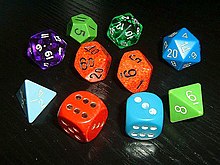
Typical role-playing dice, showing a variety of colors and styles. Notation the older hand-inked green 12-sided die (showing an 11), manufactured before pre-inked dice were common. Many players collect or acquire a big number of mixed and unmatching dice.
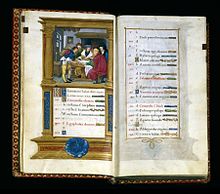
Polyhedral dice are commonly used in function-playing games. The fantasy role-playing game Dungeons & Dragons (D&D) is largely credited with popularizing dice in such games. Some games use just 1 type, similar Exalted which uses only ten-sided dice. Others use numerous types for different game purposes, such as D&D, which makes utilise of all mutual polyhedral dice. Dice are normally used to determine the outcome of events. Games typically make up one's mind results either as a full on one or more than die above or below a stock-still number, or a certain number of rolls to a higher place a certain number on i or more dice. Due to circumstances or character skill, the initial ringlet may accept a number added to or subtracted from the final result, or have the role player roll extra or fewer die. To proceed track of rolls hands, dice notation is frequently used.
Many board games use dice to randomize how far pieces move or to settle conflicts. Typically, this has meant that rolling higher numbers is better. Some games, such as Axis & Allies, accept inverted this system by making the lower values more potent. In the modern age,[ when? ] a few games and game designers have approached dice in a unlike way by making each side of the die similarly valuable. In Castles of Burgundy, players spend their dice to take actions based on the die's value. In this game, a 6 is non better than a ane, or vice versa. In Quarriors (and its descendant, Dicemasters), unlike sides of the die tin can offer completely different abilities. Several sides frequently requite resources while others grant the player useful actions.[35]
Dice can be used for divination and using dice for such a purpose is chosen cleromancy. A pair of common dice is usual, though other forms of polyhedra can be used. Tibetan Buddhists sometimes use this method of divination. It is highly probable that the Pythagoreans used the Platonic solids equally dice. They referred to such dice as "the die of the gods" and they sought to understand the universe through an agreement of geometry in polyhedra.[36]
Astrological dice are a specialized set of three 12-sided die for divination; the commencement die represents the planets, the Sun, the Moon, and the nodes of the Moon, the 2nd die represents the 12 zodiac signs, and the third represents the 12 houses. A specialized icosahedron die provides the answers of the Magic 8-Ball, conventionally used to provide answers to yes-or-no questions.
Dice can be used to generate random numbers for use in passwords and cryptography applications. The Electronic Borderland Foundation describes a method by which dice can be used to generate passphrases.[37] Diceware is a method recommended for generating secure only memorable passphrases, by repeatedly rolling five dice and picking the corresponding word from a pre-generated list.[38]
Notation [edit]
In many gaming contexts, especially tabletop function-playing games, shorthand notations representing dissimilar die rolls are used. A "d" or "D" is used to point a die with a specific number of sides; for example,d4denotes a 4-sided die. If several dice of the same type are to be rolled, this is indicated by a leading number specifying the number of dice. Hence,6d8means the player should roll six 8-sided die and add the results. Modifiers to a dice roll can also be indicated as desired. For example, 3d6+4 instructs the player to roll three six-sided dice, calculate the total, and add together iv to it.
Run into as well [edit]
References [edit]
- ^ "die, northward.1". OED Online. Oxford University Printing. Retrieved ten April 2020.
- ^ Laird, Jay (2009). Encyclopedia of Play in Today's Society. SAGE Publications. pp. 171–173. ISBN978-ane-4522-6610-7.
- ^ Finkel, Irving (2008). "Board Games". Across Babylon: Fine art, Merchandise, and Affairs in the 2nd Millennium B.C. Metropolitan Museum of Fine art. p. 151. ISBN978-1-58839-295-four.
- ^ "National Museums of Scotland - Ii bone dice". nms.scran.ac.uk . Retrieved ix May 2020.
- ^ Possehl, Gregory. "Meluhha". In: J. Reade (ed.) The Indian Bounding main in Artifact. London: Kegan Paul Intl. 1996a, 133–208
- ^ ii.3, 4.38, 6.118, seven.52, 7.109
- ^ Good, Alexandra. "Knucklebones". Johns Hopkins Archaeological Museum . Retrieved xvi Apr 2015.
- ^ a b "Twenty-sided die (icosahedron) with faces inscribed with Greek messages". metmuseum.org. Retrieved 28 March 2015.
- ^ Matz, David (2002). Daily Life of the Ancient Romans . Greenwood Publishing Group. pp. 94–95. ISBN978-0-313-30326-5.
- ^ "christies.com". christies.com. Retrieved 18 June 2012.
- ^ Encyclopædia Britannica. (2019). Domino. In Britannica.com. Retrieved 23 June 2022 from https://www.britannica.com/topic/domino-game-piece
- ^ Ronan, Colin; Needham, Joseph (1986). The Shorter Scientific discipline and Civilisation in China. Cambridge University Printing. p. 55. ISBN978-0-521-31560-9.
- ^ Salter, Rebecca (2006). "Lath Games". Japanese Popular Prints: From Votive Slips to Playing Cards. University of Hawaii Press. p. 164. ISBN978-0-8248-3083-0.
- ^ "Die Sizes Explained". Die Game Depot. 2018.
- ^ Cf. Greek Anthology Book 14, §8: "The Opposite Pairs of Numbers on a Die. The numbers on a die run so: 6 i, 5 ii, three iv."
- ^ a b "Standard Dice". Archived from the original on 30 July 2013.
- ^ "Chinese Dice". Elliott Avedon Museum & Annal of Games. Archived from the original on 1 May 2008.
- ^ "7 Surprising Facts About How Dice Are Made (With Pictures)". gmdice.com . Retrieved 20 August 2019.
- ^ "How Die Are Made". Awesome Dice.
- ^ "Casino Dice". www.dice-play.com . Retrieved 1 July 2018.
- ^ "dice". Oxford Dictionaries. Retrieved xiv February 2015.
- ^ "ace". AskOxford. Retrieved 18 June 2012.
- ^ Conant, Levi Leonard (1896). The Number Concept: Its Origin and Development. Macmillan. p. 124.
- ^ "southward | Search Online Etymology Dictionary". www.etymonline.com.
- ^ "Dice faces in cake Miscellaneous Symbols" (PDF). The Unicode standard.
- ^ Horridge, Kevin (27 November 2017). "vi Ways Casinos Stop Dice Cheats". Casino.org . Retrieved 11 October 2019.
- ^ Peterson, Jon (July 2012). Playing at the Globe: A History of Simulating Wars, People and Fantastic Adventures, from Chess to Office-Playing Games. Unreason Press. pp. 315–318. ISBN978-0-615-64204-8.
- ^ Paret, Michelle; Martz, Eston (2009). "Tumbling Dice & Birthdays: Understanding the Central Limit Theorem" (PDF). Minitab. Archived from the original (PDF) on 1 November 2013. Retrieved 29 September 2013.
- ^ Girdwood, Andrew (30 March 2019). "What'due south a spindown dice and are standard d20s whatsoever fairer?". Retrieved 9 July 2020.
- ^ Kybos, Alea. "Properties of Dice" (PDF). Archived from the original (PDF) on 28 May 2012. Retrieved 7 October 2012.
- ^ "games.rengeekcentral.com". games.rengeekcentral.com. Retrieved 18 June 2012.
- ^ "wwmat.mat.fc.ul.pt" (PDF) . Retrieved 18 June 2012.
- ^ "Specialist D6". em4miniatures . Retrieved 18 August 2017.
- ^ a b "[TMP] 'What are Average Die' Topic". The Miniatures Page. 20 November 2009. Retrieved xviii August 2017.
- ^ "Making better employ of dice in games". 2 October 2014.
- ^ Guthrie, Kenneth (1988). The Pythagorean sourcebook and library: an anthology of ancient writings which relate to Pythagoras and Pythagorean philosophy. M Rapids, MI: Phanes Printing. ISBN978-0-933999-fifty-3. OCLC 255212063.
- ^ "EFF Dice-Generated Passphrases". Electronic Frontier Foundation. 12 May 2016. Retrieved sixteen November 2018.
- ^ "EFF'southward New Wordlists for Random Passphrases". Electronic Frontier Foundation. 19 July 2016. Retrieved 4 December 2016.
- Diaconis, Persi; and Keller, Joseph B.; "Off-white Die", The American Mathematical Monthly, 96(four):337–339, 1989 (Discussion of die that are off-white "by symmetry" and "past continuity".)
- Iverson, G. R.; Longcour, Due west. H.; et al.; Bias and Runs in Die Throwing and Recording: A Few Million Throws, Psychometrika, vol. 36, no. 1, March 1971
- Knizia, Reiner, Die Games Properly Explained, Elliot Right Way Books, 1999, ISBN 0-7160-2112-9
External links [edit]
| | Look up die in Wiktionary, the gratis dictionary. |
| | Wikimedia Commons has media related to Dice. |
- Weisstein, Eric W. "Dice". MathWorld. – assay of dice probabilities, also featuring Uspenski's work on rolling multiple dice
This article incorporates text from a publication now in the public domain:Chisholm, Hugh, ed. (1911). "Die". Encyclopædia Britannica. Vol. 8 (11th ed.). Cambridge University Press. p. 176–177.
Source: https://en.wikipedia.org/wiki/Dice
0 Response to "Where Can I Buy 20 Sided Dice Near Me"
Post a Comment